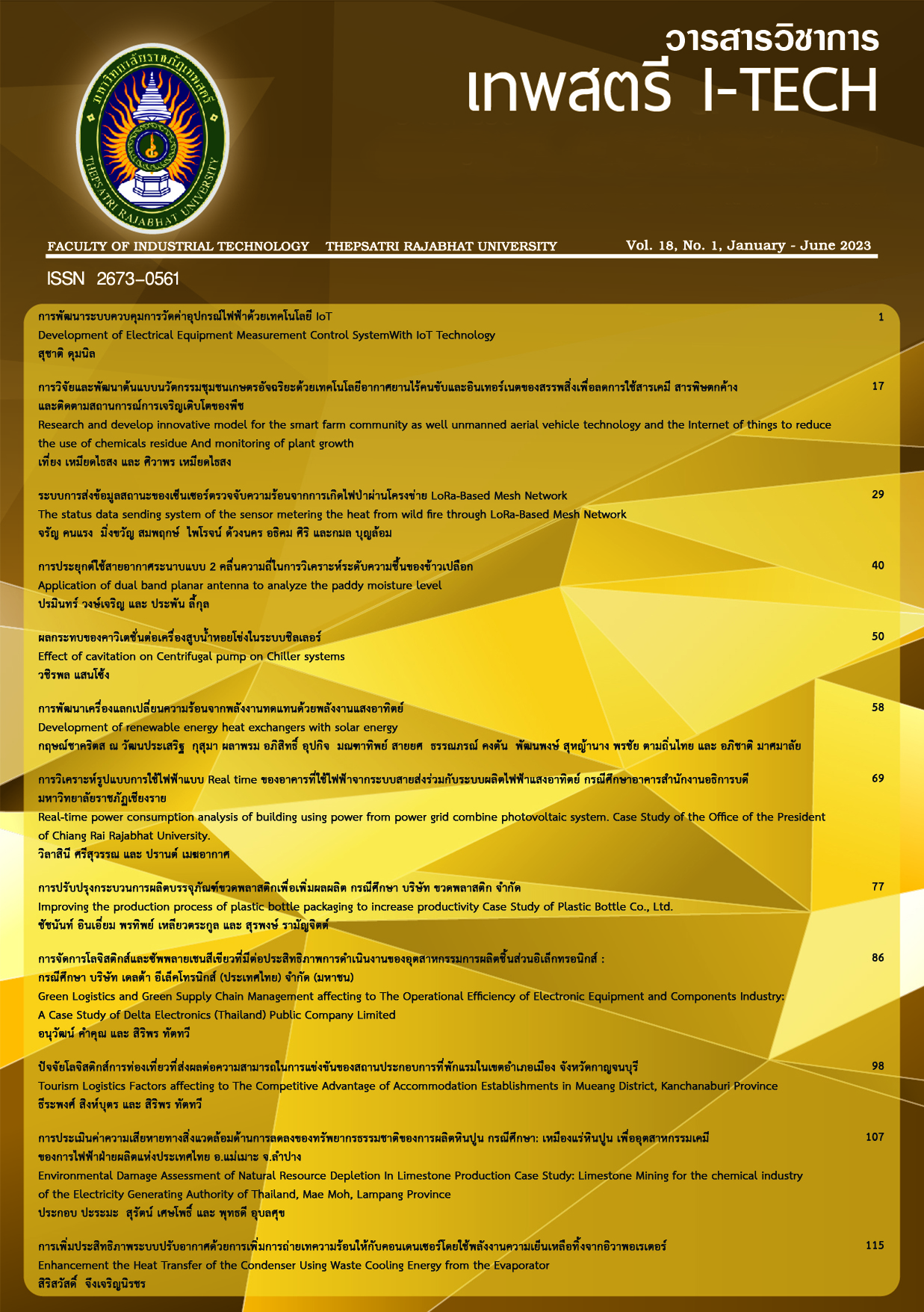การวิเคราะห์รูปแบบการใช้ไฟฟ้าตามเวลาจริงของอาคารที่ใช้ไฟฟ้าจากระบบสายส่งร่วมกับระบบผลิตไฟฟ้าแสงอาทิตย์ กรณีศึกษาอาคารสำนักงานอธิการบดีมหาวิทยาลัยราชภัฏเชียงราย
Abstract
การใช้ระบบผลิตไฟฟ้าแสงอาทิตย์เป็นที่นิยมมากขึ้นในปัจจุบัน การศึกษารูปแบบการใช้พลังงานในอาคารหลังการติดตั้งระบบผลิตไฟฟ้าแสงอาทิตย์แล้วจะช่วยให้ได้แนวทางเพื่อเพิ่มประสิทธิภาพของการใช้ไฟฟ้าจากระบบผลิตไฟฟ้าแสงอาทิตย์ได้ งานวิจัยนี้จึงมีเป้าหมายเพื่อวิเคราะห์หารูปแบบการใช้ไฟฟ้าของอาคารที่ใช้ไฟฟ้าจากระบบสายส่งร่วมกับระบบผลิตไฟฟ้าแสงอาทิตย์ และเพื่อวางแนวทางการเพิ่มประสิทธิภาพและการนำระบบผลิตไฟฟ้าแสงอาทิตย์มาใช้ในมหาวิทยาลัยราชภัฏเชียงรายเพิ่มขึ้น การศึกษาพบว่าจากการวิเคราะห์ข้อมูลที่เก็บรวบรวมข้อมูลได้จากการใช้ชุดตรวจวัดไฟฟ้ามัลติฟังก์ชั่น ที่เชื่อมต่อกับแหล่งจ่ายไฟฟ้าของอาคารสำนักงานอธิการบดี มหาวิทยาลัยราชภัฏเชียงราย ได้แสดงรูปแบบการใช้ไฟฟ้าของอาคารแยกได้สองกรณี กรณีแรกจากแหล่งจ่ายไฟฟ้าของอาคารมีสี่รูปแบบ กรณีที่สองจากการใช้ไฟฟ้าภายในอาคารมีสี่รูปแบบ โดยรูปแบบทั้งหมดให้แนวทางการเพิ่มประสิทธิภาพ เช่น ใช้ระบบควบคุมอัตโนมัติในระบบไฟฟ้าอาคาร วิเคราะห์การใช้ไฟฟ้าในอาคารก่อนและหลังใช้ระบบ ใช้มาตรการปรับเปลี่ยนพฤติกรรมการใช้ไฟฟ้า เป็นต้น การศึกษารูปแบบการใช้ไฟฟ้าของอาคารนี้สามารถนำไปเป็นแนวทางสำหรับการศึกษาในอาคารอื่น ๆ ของมหาวิทยาลัยที่ติดตั้งระบบผลิตไฟฟ้าแสงอาทิตย์แล้ว และที่ยังไม่ได้ติดตั้งระบบได้
References
P. Marish Kumar, R. Saravanakumar, A. Karthick, and V. Mohanavel, “Artificial neural network-based output power prediction of grid-connected semitransparent photovoltaic system,” Environmental Science and Pollution Research, vol. 29, pp. 10173–10182, 2022, doi: 10.1007/s11356-021-16398-6/Published.
W. Marańda, “Analysis of self-consumption of energy from grid-connected photovoltaic system for various load scenarios with short-term buffering,” SN Appl Sci, vol. 1, no. 5, May 2019, doi: 10.1007/s42452-019-0432-5.
F. Mosannenzadeh, A. Bisello, R. Vaccaro, V. D’Alonzo, G. W. Hunter, and D. Vettorato, “Smart energy city development: A story told by urban planners,” Cities, vol. 64, pp. 54–65, Apr. 2017, doi: 10.1016/j.cities.2017.02.001.
A. Lewandowska, J. Chodkowska-Miszczuk, K. Rogatka, and T. Starczewski, “Smart energy in a smart city: Utopia or reality? evidence from Poland,” Energies (Basel), vol. 13, no. 21, Nov. 2020, doi: 10.3390/en13215795.
A. Boretti and S. Castelletto, “Cost and performance of CSP and PV plants of capacity above 100 MW operating in the United States of America,” Renewable Energy Focus, vol. 39, pp. 90–98, Dec. 2021, doi: 10.1016/J.REF.2021.07.006.
J. Li et al., “How to make better use of intermittent and variable energy? A review of wind and photovoltaic power consumption in China,” Renewable and Sustainable Energy Reviews, vol. 137. Elsevier Ltd, Mar. 01, 2021. doi: 10.1016/j.rser.2020.110626.
W. Bouaguel and T. Alsulimani, “Understanding the Factors Influencing Consumers’ Intention toward Shifting to Solar Energy Technology for Residential Use in Saudi Arabia Using the Technology Acceptance Model,” Sustainability (Switzerland), vol. 14, no. 18, Sep. 2022, doi: 10.3390/su141811356.
M. of E. Energy Policy and Planning office (EPPO), “Resolutions of the meeting of the National Energy Policy Council,” Bangkok, 2021.
S. Wei and X. Bai, “Multi‐Step Short‐Term Building Energy Consumption Forecasting Based on Singular Spectrum Analysis and Hybrid Neural Network,” Energies (Basel), vol. 15, no. 5, Mar. 2022, doi: 10.3390/en15051743.
M. Heidarinejad, J. G. Cedeño-Laurent, J. R. Wentz, N. M. Rekstad, J. D. Spengler, and J. Srebric, “Actual building energy use patterns and their implications for predictive modeling,” Energy Convers Manag, vol. 144, pp. 164–180, 2017, doi: 10.1016/j.enconman.2017.04.003.
Z. Liu, Y. Liu, B. J. He, W. Xu, G. Jin, and X. Zhang, “Application and suitability analysis of the key technologies in nearly zero energy buildings in China,” Renewable and Sustainable Energy Reviews, vol. 101, pp. 329–345, Mar. 2019, doi: 10.1016/J.RSER.2018.11.023.
M. Shao, X. Wang, Z. Bu, X. Chen, and Y. Wang, “Prediction of energy consumption in hotel buildings via support vector machines,” Sustain Cities Soc, vol. 57, p. 102128, Jun. 2020, doi: 10.1016/J.SCS.2020.102128.
P. Piriyasatta, “Using Photovoltaic System on The Faculty of Architecture’s Building Rooftop in Khon Kaen University for Energy Conservation,” Built Environment Inquiry (ARCH KKU) Journal, vol. 15, no. 1, pp. 183–200, 2016. (In Thai)

